ing the quality and competency <strong>of</strong> mediators,at least in terms <strong>of</strong> requiring training.A few weeks later, the Association forConflict Resolution (ACR) published draftModel Standards for Mediation CertificationPrograms 8 and invited commentfrom its 4,000 mediator membersin (mainly) the US.I expect mediation service providersaround the world to collaborate and buyinto simple, non-bureaucratic and voluntaryhigh-level international competency,practice and ethical standards. I believemediators will see the huge value in seekingfeedback about their skills from usersand peers and have it condensed into anobjective summary by an independent personor institution for inclusion as a crediblepart <strong>of</strong> their pr<strong>of</strong>ile. I expect users torely less on gossip and hearsay when selectingmediators and to focus much moreon user feedback summaries. This will applyfar beyond mediation to include almostall pr<strong>of</strong>essional services.The Demand-Side – Userneeds are changingWhile real estate brokers recite the dogmaLocation, Location, Location, the mantra<strong>of</strong> companies, government agencies andothers that need to account to their stakeholdersis Outcomes, Outcomes, Outcomes.I have already mentioned the shift fromInputs towards more Outcome Based Educationby an increasing number <strong>of</strong> schools,universities and pr<strong>of</strong>essional institutions,but ultimately it is the demand side thatdrives such changes.The legal pr<strong>of</strong>ession, gatekeeper <strong>of</strong> mostdisputes, is changing as a result. What Pr<strong>of</strong>essorJulie Macfarlane at the University<strong>of</strong> Windsor, Ontario so aptly describes asThe New Lawyer 9 is arriving onto the scene– pragmatic, impatient, creative, daring,solution and results-orientated, processintolerant,favouring (and skilled in) negotiation,mediation, collaborative practiceand restorative justice. Resumés are beingre-written.These New Lawyers are in the market forjobs in the world’s companies and governments.They are the ones that will increasinglybe running day-to-day dispute portfolios,instructing counsel their way andin so doing changing the practice <strong>of</strong>law. A different type <strong>of</strong> client is nowemerging, with new priorities, needs andexpectations 10 .Government austerity programs are trimmingthe cost <strong>of</strong> civil justice to the publicpurse, causing sharply increased judicialinterest in the resolution <strong>of</strong> disputes beforetrial. Almost mandatory mediation is justaround the corner.All this will fuel a rise in collaborative law,where counsel are instructed to resolve acase outside the courtroom but are expresslyexcluded from representing the clientin court should negotiations fail. Mediationwill be well-understood by the NewLawyers, who will typically have beenwell-trained in those areas at Law School,independently or in-house. They will bemore selective about the skills and attitudesthey value in outside counsel. They willexpect less legal analysis and more energeticoutcome orientation. They will havetools at their fingertips to determine whatresolution process to pursue, such as administeredor non-administered mediation,and will be adept at selecting the rightmediator – having been trained in that skill.This new breed is too impatient to wastetime asking for information; if what theyneed to know about a given mediator doesnot jump out <strong>of</strong> their screens in a convincingand credible way, they will simply lookto another mediator who provides that informationopenly. Institutions that restrictinformation access to certain visitors, suchas members who must login and providepassword details, or those that use outdatedweb tools, and mediators who do not <strong>of</strong>fercredible and easily digestible and feedback,will be marginalized by many users.There will also be a rise in innovations –engagement <strong>of</strong> mediators in dealmaking,hybrids, inter-cultural intermediaries,counsel whose client is the deal, not aparty to it. The opportunities for mediationare immense.The way to predict thefuture is to invent itFor the future to leak out requires a cut intosome <strong>of</strong> today’s realities: an appreciation<strong>of</strong> the main drivers 11 , an assumption thatstakeholders on the service side (mediators,providers and trainers) will act in a waythat serves their short and medium terminterests in light <strong>of</strong> a changing market, andthat those on the demand side (users, adjudicators,educators and governments) willexpress their needs clearly. We can alsoassume that there will continue to be asteady rise in the incidence <strong>of</strong> disputes, anongoing user desire to rank outcomesabove process, and an ever more educatedand informed user base.Another reality is that mediation is a highlyfragmented field. Service providers are instrong competition. This inhibits properdialogue about the future and the ability <strong>of</strong>the main players to agree concrete goalsfor the field. Mediation, like any other endeavour,has its sceptics - those prematurelydisappointed in the future and unableor unwilling to change - as well asCanadian Arbitration and Mediation Journal38
visionaries and leaders who have alreadybeaten a path through uncharted territory,appreciated that the future belongs to thosewho prepare now, and are willing to pursuebigger targets in the absence <strong>of</strong> an overallpr<strong>of</strong>essional mission.This balkanized field is pulled in differentdirections, unsure whether it is a branch <strong>of</strong>law or psychology, an art or science, <strong>ADR</strong>or negotiation, and whether it needs a philosophy,a theory, values, characteristics,practices or all or some <strong>of</strong> these things. Tocontinue the debate but stop the dithering,mediation needs strong, well-funded, nonhierarchicalnon-service-providing pr<strong>of</strong>essionalbodies, founded on the principles <strong>of</strong>Servant Leadership 12 as explained by theorganizational guru Robert K. Greenleaf -in this case establishing and transparentlyimplementing high training and practicestandards, objectively explaining and promotingmediation to users, convening allstakeholders, making information freelyavailable, encouraging thought leadershipand best practices, developing and disseminatingtools, and convincingly inspiringmediation’s growth.Conspicuously, such bodies will be run notby practicing mediators, providers or trainers,but by full-time managers, drawing onsupport and contributions from both thedemand and supply sides. Governmentshave an interest as a user and a vital role inproviding credible seed funding so that thenew pr<strong>of</strong>ession is not perceived as purelyself-serving.Once established, these pr<strong>of</strong>essional institutionswill be empowered to establish highstandards, disallow mediocrity and ensuretransparency. They will apply, as Pr<strong>of</strong>essorSander has already predicted, strictstandards for trainers. Independent assessmentwill become a key part <strong>of</strong> those standards.While many mediators will be lawyersby background, increasingly otherpr<strong>of</strong>essionals will enter and enrich the field.By 2020, such bodies will have been establishedin most countries on a nationallevel, and will link to an international bodythat will help the pr<strong>of</strong>ession to globalise.While mediation’s stakeholders addressquality, transparency and pr<strong>of</strong>essional status,numerous other changes will occur.As the impact <strong>of</strong> communications technologygrows, small claims will typically becommoditised using ODR 13 . Mediators andproviders handling larger disputes andthose involving emotional issues willfind telepresence, online caucus roomsand other IT tools to make mediationsmore effective, attractive and affordable,reducing travel time and speeding up negotiations.As users become better informed abouthow and why mediation works, demand forless conventional, more tailored processeswill increase; hybrids <strong>of</strong> facilitative andevaluative elements, including early caseassessment and non-binding opinions, willgrow. Many trainers still teach a purely facilitativemodel <strong>of</strong> mediation, but mediatorsalso need to learn how, when andwhether to deploy evaluative and transformativetechniques as needed. Gradually,training will adapt to include these needs.More mediation panels will be process and/or subject-matter oriented, requiring mediatorsto demonstrate, in addition to theirmediation competencies, knowledge <strong>of</strong>technical fields, conflict diagnostics, processdesign and inter-cultural communications.Mediation will no longer be viewedas an alternative form <strong>of</strong> dispute resolutionand will elevate to become the primaryform. In the commercial arena, good conflictmanagement will be considered part<strong>of</strong> Good Corporate Governance and companieswill design their own systems forevaluating, managing and resolving disputes14 . A more informed and circumspectuser will emerge.Service-sidestakeholders will:• collaborate more on issues like training,independent assessment andfeedback• agree on, and apply, minimum highlevelquality standards• encourage transparency into mediatorcompetency and prior user experience• share technology platforms for ensuringsecurity and confidentiality• devise schemes to enable new mediatorsto gain experience and develop pr<strong>of</strong>essionally• insist on rigorous ethical codes and independentreviews with sanctions, and• pool resources to promote mediation asa credible pr<strong>of</strong>ession.Codes <strong>of</strong> Ethics will be re-drafted to sharecommon principles throughout the field.They will also be less legalistic and general.Ethics codes that are not subject toindependent review will be seen as meaningless;compliance panels will be associatedwith pr<strong>of</strong>essional institutions, not provider,peer or voluntary practice groups.Users will expect every practicing mediatorto carry pr<strong>of</strong>essional indemnity insuranceand to specify both the underwriterand extent <strong>of</strong> cover on their pr<strong>of</strong>ile.Users will also want hard evidence <strong>of</strong> amediator’s skills to enable them to makeinformed decisions. Cherry-picked quotationsfrom (usually) unidentified users willlack credibility. Users will expect an independently-preparedsummary <strong>of</strong> prior userfeedback not only for reassurance aboutcompetency but to indicate suitability interms <strong>of</strong> style and personality. Mediatorsposting video clips <strong>of</strong> themselves explainingtheir resumés direct to camera or ininterview mode will secure more mediationassignments, as users become increasinglymeticulous and personal in theirchoice <strong>of</strong> mediator.As OBE becomes more prevalent, thosemoving into careers in pr<strong>of</strong>essional firms,companies and governments will exhibit adifferent attitude to their predecessors,seeking specialist training in solution-providingprograms. Mediation trainers willaddress this market by segmenting theircourses; one-size-fits-all training programswill fade away. Those aspiring to becomepr<strong>of</strong>essional mediators will need more indepthtraining resulting in qualification andcertification, plus pr<strong>of</strong>essional developmentfollow-up. Pr<strong>of</strong>essional firms as wellas government and corporate users willdemand courses on representing clients inmediations; adjudicators and others willseek courses on the art <strong>of</strong> referring partiesto mediation; practicing mediators willwant courses on inter-cultural mediationand other in-depth practice areas. MajorLe Journal canadien d'arbitrage et de médiation39







